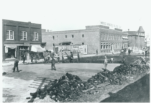City Notebook: Here’s the math on taxes
By COLLIN GALLANT on March 2, 2024.
cgallant@medicinehatnews.com@CollinGallant This column has attempted to inform folks over the years to how changes in tax rates and assessment work. Also, from time to time, income tax brackets, though that’s been mostly silent since the 2015 provincial election, and may not be tinkered with again until the 2027 election. Yet, on the property tax front, the widely held and incorrect perception still exists that rising property values supercharge property tax bills. That’s not how it works for a city’s portion of the bill, but not exactly on every bill. Mind you, it’s not an unreasonable thought to hear that an approved 4 per cent tax increase and assessments rose by, say, 4 per cent, so that adds up to 8 per cent higher tax bill. The News took another dart this week that we’re somehow in cahoots with the bureaucrats’ big tax-and-spend agenda, somehow triple-crossing the public with bamboozling math. It’s a knee-jerk reaction that already too-high taxes compound and, boy, don’t they find a way to shaft you? It doesn’t help that the property tax system is built like nothing else people deal with. But, if you’re into algebra, then you’ll see that X (assessment value) multiplied by Y (the tax rate) equals Z (the bill). On a large scale it’s the entire assessment in the city, times the mill rate, equals the amount of tax revenue in the city budget. If X or Y changes the other is adjusted up or down in opposite fashion to get to Z. A handful of times in recent years, mill rates have fallen but bills still rise because assessment rose. So that settles it. Except, right on cue, the province is now doing the opposite on their one-third portion of local bills related to education amounts. They froze the rate in this week’s budget (which sounds great), but raising assessments will see about $200 million more collected, according to analysis by Alberta Municipalities. Sigh. Time: An illusion An article in the L.A. Times tells us that without leap day, the cumulative difference over the last 2,000 years would currently see us sign our cheques June 2025. Luckily, we’ve avoided this fate by observing an extra day in February. But did you know that over the last 52 years, a total of 37 “leap seconds” have been added to atomic clocks around the world. That keeps the modern world’s high-tech systems running, banks transacting and planes landing. It’s eons beyond the debate had in Medicine Hat 110 years of so ago about adopting railroad time rather than setting “local” time by the noon-day sun. Either way, we won’t have to worry about Feb. 29 again until 2028, though we do ‘spring ahead’ next weekend. Worth seeing Next weekend marks the end of an exhibit by former News photographer Tim Smith at the Esplanade that chronicles the daily lives on Hutterite colonies across the Prairies. Smith, who is now based in Brandon, has spent more than a decade on the study that has produced substantial representations of the rural experience. The exhibit ends March 9, and rumour has it the artist will be back in these parts for its conclusion. A look ahead City council sits Monday and will take up proposed updates to its closed-meeting policy on an otherwise slim agenda that features a public hearing on zoning. After two afternoons this week and receiving the provincial budget, the Alberta legislature has risen until March 11 – a usual turn to give MLAs a chance to chat with constituents about the financial plan. Further to this, Finance Minister Nate Horner is in town Wednesday to present his thoughts to a Chamber of Commerce luncheon. 100 years ago Picnic and hunting parties may be allowed special licences to include refreshments, Premier Greenfield promised as the lengthy committee work of liquor legislation wore on, the News reported in early March 1924. Those in contravention might find their vehicles seized. A million-dollar proposal to build industry around the Many Island gas fields would include a potential helium extraction plant, stated Sarnia Oil and Gas Co. Announced after acquiring the rights located northeast of the city from a Spokane-based oil Co. and Medicine Hat Development Co. Chas. Hatfield, the famous rainmaker who had camped in Medicine Hat, had been offered a $1,000 per-inch contract by the board of supervisors in San Bernardino, Calif. Among highway improvements in the provincial budget would see the Hat to Calgary route improved in parts totalling 25 miles at Strathmore, Tilley and Alderson. Work totalling 125 miles around the province would cost $3.5 million. Collin Gallant covers city politics and a variety of topics for the News. Reach him at 403-538-5664 or via email at cgallant@medicinehatnews.com. 34-33




